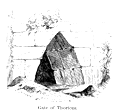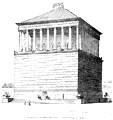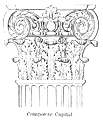Architectūra
(
ἀρχιτεκτονία, ἀρχιτεχτονική).
I. Greek
Of the earliest efforts of the Greeks in architecture we have evidence in the so-called
Cyclopean Walls surrounding the castles of kings in the Heroic Age of Tiryns, Argos, Mycenae,
and elsewhere. They are of enormous thickness, some being constructed of rude, colossal
blocks, whose gaps are filled up with smaller stones; while others are built of stones more
or less carefully hewn, their interstices exactly fitting into each other. Gradually they
begin to show an approximation to buildings with rectan gular blocks. The gates let into
these walls are closed at the top either by the courses of stone jutting over from each side
till they touch, or by a long straight block laid over the two leaning side-posts. Of the
latter kind is the famous Lion Gate at
Mycenae
(q.v.), so called from its two lions standing with their forefeet on the broad pedestal of a
pillar, and remarkable as the oldest specimen of Greek sculpture.
Among the most striking relics of this primitive age are the so-called
θησαυροί (treasuries, usually subterranean) of ancient dynasties,
the most considerable being the treasure-house of Atreus at Mycenae. (See
Mycenae.) The usual form of
 |
|
Gate of Thoricos.
|
these buildings is that of a circular chamber vaulted over by the horizontal
courses approaching from all sides till they meet. Thus the vault is not a true arch. The
interior seems originally to have been covered with metal plates, thus agreeing with Homer's
descriptions of metal as a favourite ornament of princely houses. (See
Domus.) An open-air building preserved from that age is the supposed
Temple of Heré on Mt. Ocha (now Hagios Elias ) in Euboea, a rectangle built of
regular square blocks, with walls more than a yard thick, two small windows, and a door with
leaning posts and a huge lintel in the southern side-wall. The sloping roof is of hewn
flag-stones resting on the thickness of the wall and overlapping each other, but the centre
is left open as in the hypaethral temples of a later time.
From the simple shape of a rectangular house shut in by blank walls we gradually advance to
finer and richer types, formed especially by the introduction of columns detached from the
wall and serving to support the roof and ceiling. Even in Homer we find columns in the
palaces to support the halls that surround the court-yard and the ceiling of the
banqueting-room. The construction of columns (see
Columna) received its artistic development first from the Dorians, after their
migration into the Peloponnesus about B.C. 1000, next from the Ionians—and from
each in a form suitable to their several characters. If the simple, serious character of the
Dorians speaks in the Doric order, no less does the lighter, nimbler, and more showy genius
of the Ionian race appear in the order named after them. By about B.C. 650, the Ionic style
was flourishing side by side with the Doric.
As it was in the construction of temples that architecture had developed her favourite
forms, all other public buildings borrowed their artistic character from the temple. (See
Templum.) The structure and furniture of private
houses were, during the best days of Greece, kept down to the simplest forms. About B.C. 600,
in the Greek islands and on the coast of Asia Minor, we come across the first architects
known to us by name. It was then that Rhoecus and Theodorus of Samos, celebrated likewise as
inventors of casting in bronze, built the great Temple of Heré in that island,
while Chersiphron of Cnosus in Crete, with his son Metagenes, began the Temple of Artemis at
Ephesus, one of the seven wonders of the world, which was not finished till one hundred and
twenty years after. In Greece Proper a vast temple to Zeus was begun at Athens in the sixth
century B.C. (see
Olympieum), and two more at Delphi and Olympia—one of the Corinthian Spintharus, the other by
the Elean Libon. Here, and in the western colonies, the Doric style still predominated
everywhere. Among the chief remains of this period, in addition to many ruined temples in
Sicily, especially at Selinus and Agrigentum, should be mentioned the Temple of Poseidon at
Paestum (Posidonia) in South Italy, one of the best preserved and most beautiful relics of
antiquity. The patriotic fervour of the Persian Wars created a general expansion of Greek
life, in which architecture and the sister art of sculpture were not slow to take a part. In
these departments, as in the whole onward movement, a central position was taken by Athens,
whose leading statesmen, Cimon and Pericles, lavished the great resources of the state at
once in strengthening and
 |
|
Porch of the Erechtheum at Athens. (Drawing by Boudier.)
|
beautifying the city. During this period arose a group of masterpieces that still
astonish us in their ruins, some in the forms of a softened Doric, others in the Ionic style,
which had now found its way into Attica, and was here developed into nobler shapes. The Doric
order is represented by the Temple of
Theseus; the
Propylaea (q.v.), built by Mnesicles; the
Parthenon (q.v.), a joint production of Ictinus and Callicrates—while the
Erechtheum (q.v.) is the most brilliant
creation of the Ionic order in Attica. See
Athenae.
The progress of the drama to its perfection in this period led to a corresponding
improvement in the building of theatres. A stone theatre was begun at Athens even before the
Persian Wars, and the Odeum of Pericles served similar purposes. How soon the highest results
were achieved in this department, when once the fundamental forms had thus been laid
down in outline at Athens, is shown by the theatre at Epidaurus, a work of Polyclitus,
unsurpassed, as the ancients testify, by any later theatres in harmony and beauty. Another
was built at Syracuse before B.C. 420. Nor is it only in the erection of single buildings
that the great advance then made by architecture shows itself. In laying out new towns, or
parts of towns, men began to proceed on artistic principles, an innovation due to Hippodamus
of Miletus. See
Theatrum.
In the fourth century B.C., owing to the change wrought in the Greek mind by the
Peloponnesian War, in place of the pure and even tone of the preceding period, a desire for
effect became more and more general, both in architecture and sculpture. The sober Doric
style fell into abeyance and gave way to the Ionic, by the side of which a new order, the
Corinthian, said to have been invented by the sculptor Callimachus, with its more gorgeous
decorations, became increasingly fashionable. In the first half of the fourth century arose
what the ancients considered the largest and grandest temple in the Peloponnesus, that of
Athené at Tegea, a work of the sculptor and architect Scopas. During the middle of
the century another of the “seven wonders,” the splendid tomb of Mausolus
at Halicarnassus, was constructed. (See
Mausoleum.) Many magnificent temples arose in that time. In Asia Minor, the temple at
Ephesus, burned down by Herostratus, was rebuilt by Alexander's bold architect Dinocrates. In
the islands the ruins of the Temple of Athené at Priené, of Apollo
 |
|
Mausoleum at Halicarnassus. (Restoration by Reber.)
|
at Miletus, of Dionysus at Teos, and others, even to this day offer a brilliant
testimony to their former magnificence. Among Athenian buildings of that age the Monument of
Lysicrates (q.v.) is conspicuous for its
graceful elegance and elaborate development of the Corinthian style. In the succeeding age,
Greek architecture shows its finest achievements in the building of theatres, especially
those of Asiatic towns; in the gorgeous palaces of newly built royal capitals; and in general
in the luxurious completeness of private buildings. As an important specimen of the last age
of Attic architecture may also be mentioned the Tower of the Winds at Athens. See
Andronicus.
II. Etruscan and Roman
In architecture, as well as sculpture, the Romans were long under the influence of the
Etruscans, who, though not possessing the gift of rising to the ideal, united wonderful
activity and inventiveness with a passion for covering their buildings with rich ornamental
carving. None of their temples have survived, for they built all the upper parts of wood; but
many proofs of their activity in building remain, surviving from various ages, in the shape
of tombs and walls. The latter clearly show how they progressed from piling up polygonal
blocks in Cyclopean style to regular courses of squared stone. Here and there a building
still shows that the Etruscans originally made vaultings by letting horizontal courses jut
over, as in the ancient Greek
θησαυροί above mentioned: on
the other hand, some very old gateways, as at Volterra and Perugia, exhibit the true arch of
wedge-shaped stones, the introduction of which into Italy is probably due to Etruscan
ingenuity, and from the introduction of which a new and magnificent development of
architecture takes its rise. The most imposing of ancient Italian arch building is to be seen
in the sewers of Rome constructed in the sixth century B.C. See
Cloaca.
When all other traces of Etruscan influence were being swept away at Rome by the intrusion
of Greek forms of art, especially after the conquest of Greece in the middle of the second
century B.C., the Roman architects kept alive in full vigour the Etruscan method of building
the arch, which they developed and completed by the inventions of the cross-arch (or groined
vault) and the dome. With the arch, which admits of a bolder and more varied management of
spaces, the Romans combined, as a decorative element, the columns of the Greek orders. Among
these their growing love of pomp gave the preference more and more to the Corinthian, adding
to it afterwards a still more gorgeous embellishment in what is called the Roman or Composite
capital. Another service rendered by the Romans was the introduction of building in brick. A
more vigorous advance in Roman architecture dates from the opening of the third century B.C.,
when they began making great military roads and aqueducts. In the first half of the second
century they built, on Greek models, the first basilica, which, besides its practical
utility, served to embellish the Forum. Soon after the middle of the century appeared the
first of their more ambitious temples in the Greek style. There is simple grandeur in the
ruins of the
Tabularium (q.v.), or Record
Office, built B.C. 78 on the slope of the Capitol next the Forum. These are among the few
remains of Roman republican architecture; but in the last decades of the Republic simplicity
gradually disappeared, and men were eager to display a princely pomp in public and private
buildings; witness the first stone theatre erected by Pompey as early as B.C. 55. Then all
that went before was eclipsed by the vast works undertaken by Caesar—the Theatre,
Amphitheatre, Circus, Basilica Iulia, Forum Caesaris with its temple to Venus Genetrix. These
were finished by Augustus, under whom Roman architecture seems to have reached its
culminating-point. Augustus, aided by his son-in-law Agrippa, a man who understood building,
not only
 |
|
Arch of Titus at Rome.
|
completed his uncle's plans, but added many magnificent structures—the
Forum Augusti with its temple to Mars Ultor, the Theatre of Marcellus with its Portico of
Octavia, the Mausoleum, and others. Augustus could fairly boast that “having found
Rome a city of brick, he left it a city of marble.” The grandest monument of that
age, and one of the loftiest creations of Roman art in general, is the
Pantheon (q.v.), built by Agrippa, adjacent to, but not connected with,
his Thermae, the first of the many works of that kind in Rome. This structure is remarkable
as being the only ancient building in Rome of which the walls and arches are now in a
complete state of preservation. It was erected by Agrippa in B.C. 27, the original
inscription being still retained upon the architrave of its porch. The Pantheon is a circular
structure 146 feet and 6 inches in height and inner diameter, with a portico 103 feet long
composed of sixteen Corinthian columns, 46 feet in height. Inside the portico at the entrance
are two niches which once contained the colossal statues of Agrippa the builder, and of
Augustus Caesar. The walls of the building, which are 19 feet thick, support a dome or cupola
of vast dimensions, constructed of concrete. At the vertex of the cupola is an opening nearly
30 feet in diameter, lighting the interior.
A still more splendid aspect was imparted to the city by the rebuilding of the old town
burned down in Nero's fire, and by the “Golden House” of Nero, a gorgeous
pile, the like of which was never seen before, but which was destroyed on the violent death
of its creator. The immense and complicated structure, or rather mass of structures, known as
the Palace of the Caesars, formed one of the most striking achievements of Roman
architectural genius. (See
Palatium.) It was, as
Professor Lanciani puts it, a labyrinth of “endless suites of apartments, halls,
terraces, porticoes, crypts, and cellars,” having its main approach on the Via
Sacra. At its arched entrance was a magnificent quadriga cut from a single block of
white marble by Lysias. Beyond was a peristyle of fifty-two fluted columns adorned with a
host of exquisite statues representing the Danaïdae, and adjacent to a great
library. The magnificence of the palace as a whole may be conjectured from a simple summary
of the treasures which we know to have been lavished upon the mere vestibule—a
hundred and twenty columns of marble and bronze, statuary, bas-reliefs by Bupalus and
Anthermus, a quadriga in gilded bronze, exquisite ivory carvings, hundreds of medallions in
gold, silver, and bronze, immense collections of gold and silver plate, gems and cameos, and
a colossal bronze statue of Augustus, fifty feet in height. (See Lanciani,
Ancient
Rome in the Light of Recent Discoveries, ch. v.).
Of the luxurious grandeur of private buildings we have ocular proof in the dwelling-houses
of Pompeii, a petty country town in comparison with Rome. The progress made under the Flavian
emperors is evidenced by Vespasian's amphitheatre, known as the Colosseum, the mightiest
Roman ruin in the world; by the ruined Thermae, or Baths, of Titus, and by his triumphal
arch, the oldest specimen extant in Rome of this class of monument, itself a creation of the
Roman mind. But all previous buildings were surpassed in size and splendour when Trajan's
architect, Apollodorus of Damascus, raised the Forum Traianum with its huge Basilica Ulpia
and the still surviving Column of Trajan, besides other magnificent structures, including
libraries, a great temple, a two-storied gallery, and a triumphal arch. The Basilica had five
halls, the central one being 27 yards long, and the whole structure 61 yards wide. It was
paved with slabs of rare marble. Only a part of this Forum has yet been excavated, but enough
has been brought to light to justify the vivid description of Ammianus Marcellinus (xvi. 10),
whose account refers to the time of the emperor Constantine's visit to Rome in the year 356.
No less extensive were the works of Hadrian, who, besides adorning Athens with many
magnificent buildings, bequeathed to Rome a Temple of Venus and Roma, the most colossal of
all Roman temples (see p. 763), and his own
Mausoleum (q.v.), the core of which is preserved in the Castle of St.
 |
|
Colosseum at Rome.
|
Angelo. While the works of the Antonines already show a gradual decline in
architectural feeling, the Triumphal Arch of Severus ushers in the period of decay that set
in with the third century. In this
 |
|
Composite Capital.
|
closing period of Roman rule the buildings grow more and more
gigantic—witness the Baths of Caracalla, those of Diocletian, with his palace at
Salona (three miles from Spalatro) in Dalmatia, and the Basilica of Constantine, breathing
the last feeble gasp of ancient life. But outside of Rome and Italy, in every part of the
enormous Empire to its utmost barbarian borders, bridges, numberless remains of roads and
aqueducts and viaducts, ramparts and gateways, palaces, villas, marketplaces and
judgment-halls, baths, theatres, amphitheatres, and temples, attest the versatility, majesty,
and solidity of Roman architecture, most of whose creations only the rudest shocks have been
able to destroy. See Reber,
Hist. of Ancient Art, Eng. trans.
(N. Y.
1883); Lübke,
Geschichte der Kunst, vol. i.
(new ed.
1891); Fergusson,
Hist. of Architecture, vol. i.
(new ed.
1891); and
Balneae;
Domus;
Palatium;
Templum.










